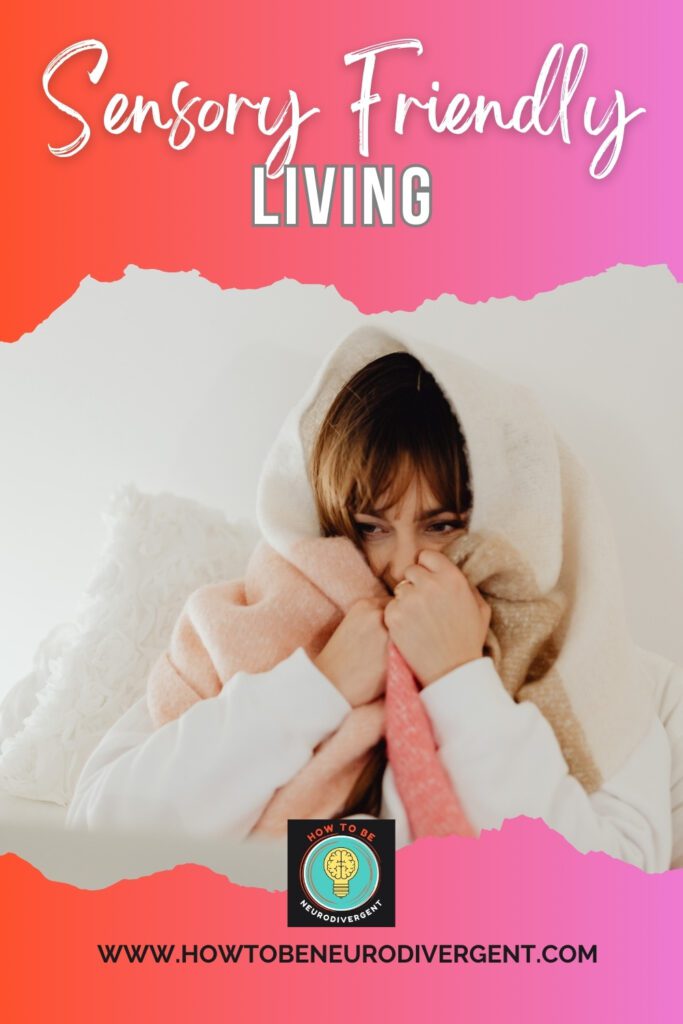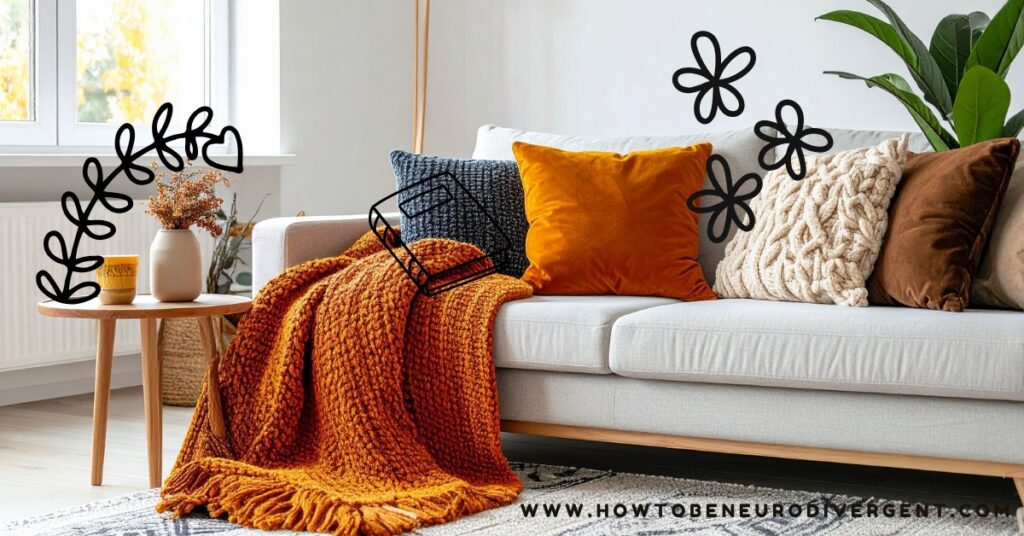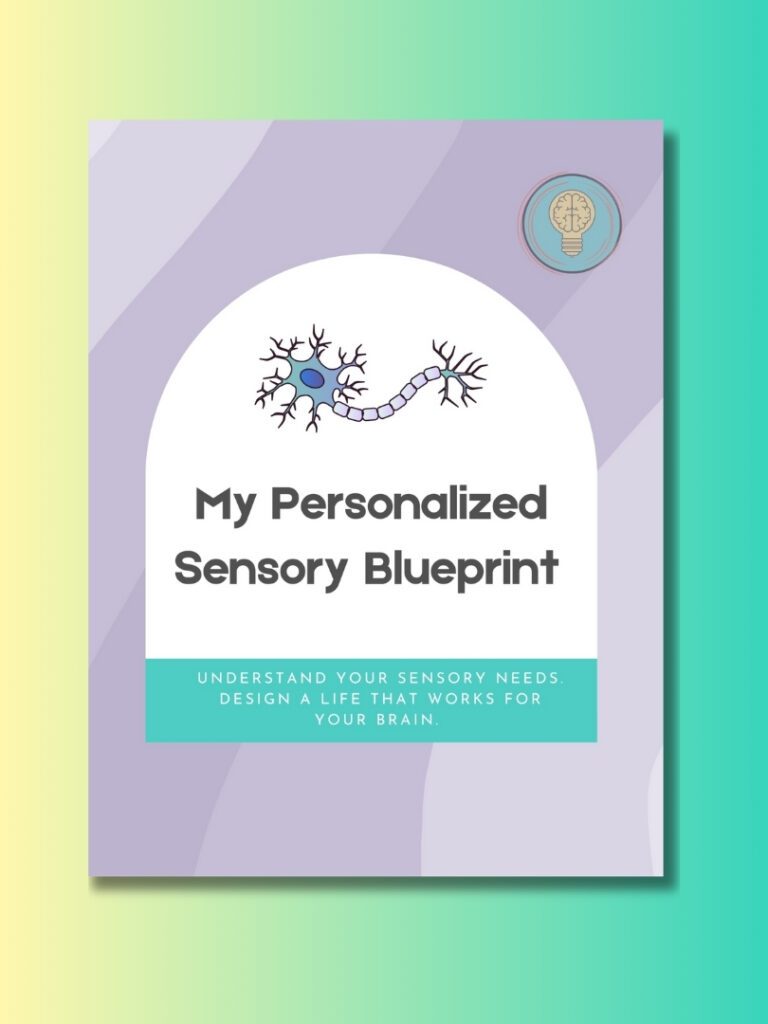Table of Contents
ToggleToo Sensitive?
Turns out “just ignore it” doesn’t always work. Sensory sensitivities are real and can cause intense physical and emotional reactions. Learning how to create a sensory-friendly life is foundational for neurodivergent well-being.
Anyone else relate to being so overcome by the itchy material of the sweater you’re wearing (that was so cute at the time, but is now so clearly a mistake), that your brain refuses to focus on anything else until it’s removed?
You can barely force a smile as the sensation spreads, and your skin feels like it’s tingling with a million fire ants. People wonder why you seem so grumpy. And maybe you wonder why you’re so sensitive yourself.
You don’t need to “tough it out.” You need practical tools that acknowledge your need for a sensory-friendly life. And that’s what this article is all about. This may be particularly applicable to adults who have, later in life, just begun to recognize their sensory sensitivities as a valid experience.
*If you haven’t already, consider reading my article describing what it means to have👉 sensory sensitivities.

Creating a Sensory-Friendly Life: Practical Solutions
Home Environment
Life is too short to go home to a space that makes you feel uncomfortable in your own skin. Here are some simple changes that can be made at home.
- Lighting: Use warm, dimmable lighting; avoid fluorescent bulbs. You may also enjoy alternatives to overhead lighting like fairy lights and strategically placed lamps. Some people may also enjoy getting creative with lighting and adding colored bulbs.
Before I knew I had sensory sensitivities, we put soft white Christmas lights around our main floor one winter. I loved it so much that we kept them up year round. I much prefer that lighting in the evening to harsh, glaring, overhead lights.
- Sound: White noise machines may help to tune out nagging and distracting sounds that make it difficult to concentrate or fall asleep. Noise-canceling headphones can also dampen ambient noise or be used to play an audiobook or favorite music that can give you something else to focus on.
I rely heavily on my headphones throughout the day. I honestly don’t know how I ever made it work without them. I also like using “sleep music” from You-Tube to help turn my brain off when I’m trying to fall asleep. It has to have that “just right” sound, though.
- Touch: Remove tags from clothing, add soft bedding, and wear texture-friendly clothing. Don’t be afraid to go for comfort over style if it calms your nervous system.
I find tights and socks with prominent seams almost unbearable. An oversized hoodie or loose fitting T-shirt is where I’m most comfortable. If I need to dress up, I prefer soft, stretchy, loose fitting dresses.
- Smell: Fragrance-free products might reduce headaches or nausea that can be induced by strong chemical scents. Some people may enjoy natural essential oils for calming or invigorating scents.
While some people may be overwhelmed by artificial scents, I am someone who loves things like scented candles and wax melts. I can spend hours in a store like Bath and Bodyworks smelling every single product in the store to find my new favorite scent.
- Furniture and Decor: Furniture is another place where you may prefer to focus on comfort over style. Having extra throw pillows and weighted blankets can also help to soothe the nervous system. Some people feel best surrounded by calming colors and reduced clutter while others enjoy the stimulation of bright happy colors and their favorite nicknacks.
I used to have bright yellow curtains in my home that brought me joy every time I looked at them. Over the years, I have also had bold teal kitchen cabinets, red walls, brightly colored throw pillows. I love bold contrasting colors. On the flip side, I find visual clutter extremely overstimulating.

Workspace or Office
Being mindful of your sensory needs at work can help you to be more productive, reduce stress levels, and optimize your energy.
- Noise: Use earplugs, headphones, or noise-dampening panels to reduce distracting sounds that could negatively affect your focus.
- Visual Clutter: Organize space with minimal distractions. Sometimes a messy or disorganized work space can cause a disorganized mind.
When I had a desk in an office, it was the most organized and uncluttered desk there. I find I’m much better at keeping spaces organized and uncluttered when I don’t have kids coming behind me and undoing it all, ha ha. I still haven’t managed to figure out how to avoid the perpetual overwhelm from that reality (as a mother of six with their own executive functioning challenges).
- Breaks: Build in quiet sensory breaks. Some sensory experiences at work are unavoidable. Try to use your breaks strategically. You may benefit from a few moments in a dark, quiet room. You may also feel more regulated and able to focus if you take stretch breaks or use fidget tools.
I used to try to get that quiet break during work hours by eating my lunch alone in my car. Sometimes I had to drive my car to another parking lot to be sure no one would come talk to me during that time. It was crucial to getting through the rest of my day with any semblance of regulation.
- Remote Work Consideration: Advocate for flexible environments if possible. It’s becoming more acceptable for people to work from home occasionally, even if a fully remote position is unavailable.
For me, the ability to work from home is an absolute revelation. I’m so glad that option is becoming more common.

On-the-Go Strategies
Traveling or being “out and about” can bring unexpected sensory overwhelm, but there are ways to be prepared for the most common disturbances.
- Sensory Emergency Kit: It can be helpful to keep a few sensory tools where you can access them if needed, like in your purse or in a bin in your car. You can include items like sunglasses, earplugs, gum, and stim toys. Weighted lap pads or stuffed animals can also help you feel grounded and reduce overwhelm.
Now that I’m more aware of my sensory needs, my purse has all the things. My ono roller, flare ear plugs, lip balm, mints, my glasses with transition lenses. My purse is full enough that it can double as a weighted lap pad, ha.
- Clothing: Comfortable, predictable fabrics can help lessen your overall sensory load. It’s also helpful to wear layers for temperature control.
I almost always carry a jacket or sweater with me “just in case.”
Public Spaces: Identify quiet rooms/spaces in malls, airports, or event venues ahead of time. These accommodations are becoming more common. If this type of space is unavailable, it’s helpful to come up with an “exit strategy” ahead of time for if things become overwhelming.

Food and Mealtime
- Textures and Preferences: Normalize and honor food aversions. You may be used to shaming yourself for being “picky,” but there are ways to get the necessary nutrition and still allow for sensory differences while eating.
For me, I lean more to the sensory seeking side of things when it comes to food. I enjoy mixing textures, flavors, sweet, sour, salty, and adding a variety of dipping sauces or hot sauce to most meals. I struggle to eat food that is too bland. On the other hand, my kids prefer bland food with components separated. We make it work by doing a lot of “build your own” style meals that have a variety of “add-ons” served separately and people can choose what they prefer.
- Meal Planning: Executive functioning differences may make this difficult, but prepping familiar and safe foods can be helpful for managing sensory regulation day to day. If you feel the need to branch out, allow yourself to explore new textures slowly.
I have lots of kids and have still not figured out how to meal prep consistently. I cook from scratch for most dinners, but I do rely heavily on prepackaged convenience food for kids’ lunches and times when I just can’t cook. That’s just my reality right now. It is an added challenge to have kids with varying degrees of food aversions and preferences. Finding one thing everyone will eat “as is” feels almost impossible.
- Dining Out Tips: It may be helpful to research menus and choose some options ahead of time. Also, eating at off-peak hours can lessen the sensory overwhelm that can often accompany crowded spaces. Don’t be afraid to use sensory supports like ear plugs or fidget toys to help with regulation.
I like to look up the menu online if I’m planning to go to a new-to-me restaurant. It significantly cuts down on the amount of time it takes me to make a decision and helps me feel more relaxed.
I also use my ear plugs if I know the venue can be loud and echoey or have music and TVs playing.

Learning Your Own Sensory Profile
If you are just discovering the extent to which sensory sensitivities affect you, it’s crucial to do the inner work of learning the things that cause dysregulation and the things that help you feel regulated.
- Tracking Triggers: One way is to keep a sensory journal. Take time to notice the sensory inputs that induce extreme discomfort or negative emotions.
If journaling is not your jam, just make a mental note and make it a priority to recognize the times you feel uncomfortable or experience anger, frustration, or irritability with no other apparent cause.
- Body Signals: If you have spent a lifetime repressing your discomfort and subconsciously masking your way through life, you may have created the bad habit of ignoring or dismissing your own body signals. Learn early signs of overwhelm so you can support your nervous system before your distress becomes unmanageable.
- Professional Support: While many occupational therapists work exclusively with children, it may be possible to find a professional who can help guide you in the process of defining your sensory profile and recommending interventions. A sensory-informed coach may be more accessible.
In my experience, it’s difficult to find professional support as a high-masking neurodivergent person. Either there are no suitable providers, the wait list is prohibitively long, or the out of pocket cost is just not accessible. But others may have more luck.
- Empowerment: Knowledge leads to better boundaries and lifestyle design. These adjustments may seem silly or unnatural at first, but it’s amazing how many small accommodations can work together to significantly improve nervous system regulation.
I’ve also found that being mindful of keeping sensory discomfort to a minimum also helps to increase my energy levels and emotional regulation throughout the day.
Encouragement and Final Thoughts
- Normalize and Validate: Sensory needs are real, valid, and (more often than not) manageable. You may not be able to completely eliminate discomfort, but there is power in noticing your needs and loving yourself enough to meet them to the best of your ability.
- Progress Over Perfection: This process will likely take a lot of trial and error. It’s part of learning what works for you on a deeply personal level. Give yourself grace, and realize that learning to accommodate your sensory needs will take time.
- Living Fully: With the right tools and understanding, sensory-friendly living enhances quality of life. Sensory accommodations can help to prevent chronic fatigue, reduce stress, ease muscle tension, and increase your feeling of well-being.
What sensory accommodations have made a significant difference in your life? Comment below to share your tips for a sensory-friendly life.
Thanks for listening, friends.

If you liked this article, you may also like:
Digital Download – My Personalized Sensory Blueprint (PDF, US Letter & A4)
Discover your sensory world with compassion and clarity.
My Personalized Sensory Blueprint is a 39-page guide and workbook designed especially for late-identified autistic, ADHD, and otherwise neurodivergent adults who are learning to better understand their sensory needs.
This guide helps you map your own sensory preferences, challenges, and accommodations—so you can create environments and routines that support your well-being.
BUY NOW for $8.00

Disclaimer:
This post reflects my personal experiences and perspectives as a late-identified neurodivergent adult. While I aim to share helpful insights, I don’t speak on behalf of the entire ADHD or autistic community. Neurodivergence is diverse and individual—please interpret this content through the lens of your own needs and experiences. This article is not a substitute for professional or medical advice.

